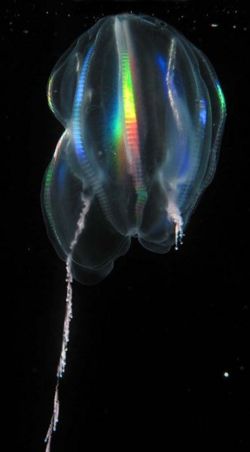Tentaculata
| Tentaculata |
|---|

|
| Scientific Classification |
|
| Orders |
|
Tentaculata is a class of comb jellies. This class of ctenophora has two tentacles that can be brought back up into the body of the organism. Some of the species in this class have secondary tentacles that also help the organism catch its prey. These tentacles are coated in special cells called "colloblasts". The colloblast is a very sticky cell that attaches itself to the prey when they touch.[1]
Anatomy
The species in the tentaculata class normally have two stringy tentacles that are brought back up inside of it into slots in the body that are specially designed for these tentacles to be stored in. Some of these species, such as the oval sea gooseberry, also have a smaller second set of tentacles. When these species have a second set of tentacles, their primary set is actually smaller in size. The species from the genus Mnemiopsis are about 4 inches long and is very common on the upper Atlantic coast. These species have a large mouth that they us to feed on larval mollusks and copepods. The very similar genus Leucothea is very populated in the Pacific coast. One of the unique species from this genus is the Venus's girdle. This organism has a very ribbon-like, flat body that can reach lengths over 1 yard. This organism is also found in tropical waters.[2]
Reproduction
All of the organisms in this class reproduce sexually and also all ctenophores are hermaphroditic, which means that they contain both male and female reproductive organs. The first process of reproduction starts with when the eggs and sperm are released into the water where they flow together and the eggs become fertilized.[3] The reproductive organs lie near the small channels of the mesogloea directly under the 'combs'. Organisms in this class emit their gametes into the water through small openings in the ectoderm, these openings are also known as gonopores, which is also where fertilisation takes place.[4] After the eggs and sperm unite and fertilize an ovoid larvae begins to grow, which is also known as a Cydippid larvae. After the eggs hatch, free swimming larvae slowly develop into full grown Comb Jellies.
Ecology
All ctenophores are carnivorous. Organisms from the class Tentaculata eat a very wide selection of creatures that they catch. All Tentaculata have two tentacles and two secondary tentacles. They use both of these sets of tentacles to catch their food and bring it up into the mouth of the Tentaculata so that it can fully digest the organism. There is a special substance that the tentacles are coated with to help them catch their prey. This substance is actually a special adhesive called "Colloblasts".[5]
Gallery
References
- Tentaculata Wikipedia
- Tentaculata Infoplease
- Tentaculata Earthlife

